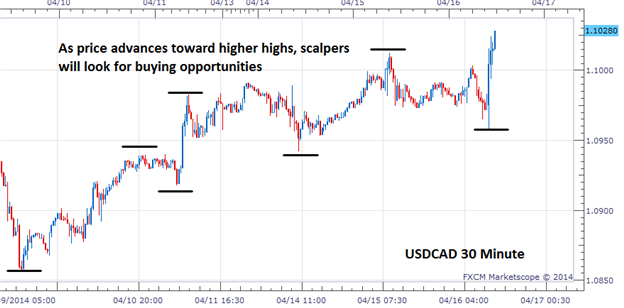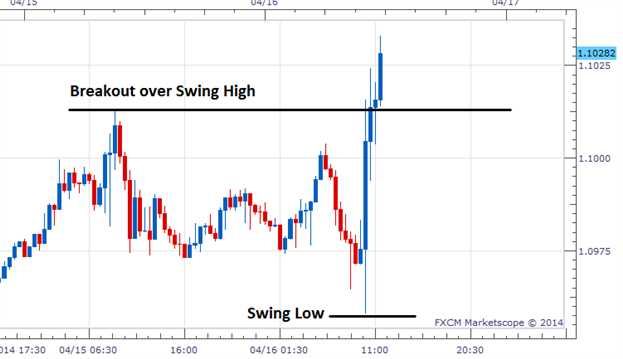Talking Points:
- Scalping strategies can be broken down into three components
- Always consider market direction and the trend
- Plan entries around retracements or breakouts
Many traders want to implement a scalping strategy,
but don’t know where to get started. The truth is, you can develop a
simple scalping strategy in as little as three steps. Today we will
review the three components of a scalping strategy. Let’s get started!
Find The Trend
The first step to scalping is finding the trend.
Finding the trend is vital because it helps create our trading bias for
a currency pair. For example, if the pair is creating a series of
higher highs, traders would only want to look for buying opportunities.
This is opposed to a graph that is moving towards lower lows, when sell
positions are preferred.
Using the example below, we can see the USDCAD
has been trending upwards with the creation of a series of higher highs
and higher lows. This means that scalpers should look for opportunities
to buy the market.
Learn Forex: USDCAD 30Min Trend

Time Your Entry
The next step in developing a scalping strategy is
to decide on an entry mechanism. Normally, scalpers will choose from
either a retracement strategy, or a breakout strategy. In an uptrend, retracementtraders focus on pullbacks in the trend, in order to buy at a lower price. This is opposed to a breakout trader that will only buy when the market breaks a key level of resistance as price forms a higher high.
Below we can see two points that scalpers could
consider as entry points. First, if price moves and forms a higher low,
this swing could be an opportune retracement for trading. Next on the
USDCAD you can see the breakout above the weeks previous high. This
point on the graph would provide an opportune point for breakout traders
to scalp in the direction of the trend.
Learn Forex: Breakout & Retracement levels

Manage Risk
The last step of any trading strategy is to manage risk.
While there are a variety of ways to place stops, traders should also
consider the told risk associated with their trade. Normally a good
frame of reference is to risk no more than 1% of your trading balance on
any 1 position. This way, in the event of a position being stopped out,
the majority of your account balance is remaining to look for other
trading opportunities.
Now that you are familiar with the 3 basics steps to
designing a scalping strategy, it’s important to find the components
that work for you. You can get started developing your own strategy with
a Free Forex Demo with FXCM. This way you can develop your trading skills while tracking the market in real time!
No comments:
Post a Comment